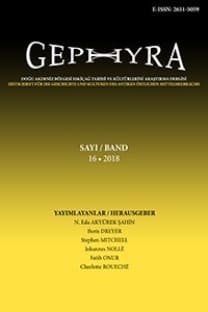Kios'dan (Gemlik) Üç Yeni Lahit
Bithynia, Kios, lahit, Gemlik, küçük objeler, Isis, Sarapis, yüzük kaşı, I. Valerianus, altın sikke
Three new sarcophagi from Kios (Gemlik)
Bithynia, Kios, sarcophagus, Gemlik, small finds, intaglio, Isis, Sarapis, Valerianus I, gold coin,
___
- N. E. Akyürek Şahin, Nikomedeia'dan İki Entelektüel: Basilikos ve Kyrion'un Mezar Epigramları, Olba XIX, 2011, 349–370.
- M. Adak, Claudia Anassa– eine Wohltäterin aus Patara, EA 27, 1996, 127–142.
- N. Asgari – N. Fıratlı, Die Nekropole von Kalchedon, in: S. Şahin – E. Schwertheim – J. Wagner (ed.), Studien zur Religion und Kultur Kleinasiens. Festschrift für F. K. Dörner zum 65. Geburtstag, Leiden 1978, 1–107.
- A. Avram, The Propontic Coast of Asia Minor, in: M. H. Hansen – T. H. Nielsen (ed.), An inventory of Archaic and Classical Poleis, Oxford 2004, 974–999.
- A. Backe-Dahmen, Die Welt der Kinder in der Antike, Mainz 2008.
- J. Boardmann – D. Scarisbrick, The Ralph Harari Collection of Finger Rings, London 1977.
- R. Bondoux, Les Villes, in: B. Geyer – J. Lefort (ed.), La Bithynie au Moyen ge (Réalités Byzantines 9), Paris 2003, 377– 409.
- S. Cormack, The Space of Death in Roman Asia Minor, Vienna 2004.
- T. Corsten, Neue Denkmäler aus Bithynien, EA 17, 1991, 79–100.
- J. A. Cramer, A geographical and historical description of Asia Minor with a map, Oxford 1832.
- F. K. Dörner, Inschriften und Denkmäler aus Bithynien, IstForsch 14, Berlin 1941.
- N. Ehrhardt, Milet und seine Kolonien. Vergleichende Untersuchung der kultischen und politischen Einrichtungen, Frankfurt am Main 1983.
- D. French, Milestones of Pontus, Galatia, Phrygia, and Lycia, ZPE 43, 1981, 149–174.
- R. Higgins, Greek and Roman Jewellery, London 1980.
- W. Hornbostel, Sarapis. Studien zur Überlieferungsgeschichte, den Erscheinungsformen und Wandlungen der Gestalt eines Gottes, EPRO 32, Leiden 1973.
- R. Ineichen, Würfel und Wahrscheinlichkeit. Stochastisches Denken in der Antike, Heidelberg–Berlin–Oxford 1996.
- G. Koch – H. Sichtermann, Römische Sarkophage, München 1982.
- G. Koch, Sarkophage der römischen Kaiserzeit, Darmstadt 1993.
- G. Koch, Türkiye'deki Roma İmparatorluk Dönemi Lahit¬leri / Sarkophage der Römischen Kaiserzeit in der Türkei, Antalya 2010.
- A. Körte, Kleinasiatische Studien IV. Ein Altphrygischer Tumulus bei Bos–öjük(Lamunia), AM 24, 1899, 1–46.
- K. Konuk – M. Arslan, Ancient Gems and Finger Rings from Asia Minor. The Yüksel Erimtan Collection, Ankara 2000.
- F. Kudlien, Die Stellung des Arztes in der römischen Gesellschaft, Stuttgart 1986.
- T. Corsten, A Lexicon of Greek Personal Names V A. Coastal Asia Minor: Pontos to Ionia, Oxford 2010.
- A. M. Mansel, Gemlik Tümülüs Mezarı, Belleten 38 (150), 1974, 181–189.
- C. Marek, Stadt, Ära und Territorium in Pontus–Bithynia und Nord–Galatia, Tübingen 1993 (IstForsch 39).
- C. Marek, Pontus et Bithynia. Die römischen Provinzen im Norden Kleinasiens, Mainz am Rhein 2003.
- R. Merkelbach – J. Stauber, Steinepigramme aus dem grie¬chischen Osten II. Die Nordküste Kleinasiens (Marmara¬meer und Pontos), München–Leipzig 2001.
- G. Perrot – E. Guillaume – J. Delbet, Exploration archéologique de la Galatie et de la Bithynie, d'une partie de la Mysie, de la Phrygie, de la Cappadoce et du Pont, Paris 1872.
- D. W. Prakken, Funerary Inscriptions in New York, AJA 58.4, 1954, 321–322.
- A. Rieche, Römische Kinder– und Gesellschaftsspiele, Stuttgart 1984.
- L. Robert, A travers l'Asie Minuere. Poètes et prosateurs, monnaies grecques, voyageurs et géographie, Paris 1980.
- G. Rodenwaldt, Ein Typus römischer Sarkophage, BJB 147, 1942, 217–228.
- K. Ruffing, Städtische Wirtschaftspolitik im hellenistisch–römischen Kleinasien? Zur Funktion der Emporia, in: H. U. Wiemer (ed.), Staatlichkeit und politisches Handeln in der römischen Kaiserzeit, Berlin 2006, 123–151.
- J. Scarborough, Romans and Physicians, CJ 65, 1970, 296–306.
- W. Schulze, Zur Geschichte lateinischer Eigennamen, Berlin 1904.
- J. Spier, Ancient Gems and Finger Rings: Catalogue of the collections / The J. Paul Getty Museum, California 1992.
- C. Tanrıver, Kios'tan iki yeni mezar steli, in: H. Malay (ed.), M. (Usman) Anabolu'ya Armağan: Presented to M. (Usman) Anabolu, Arkeoloji Dergisi II, 1994, 119–120.
- C. Texier, Asie Mineure: Description géographique, historique et archéologique des provinces et de villes de la Chersonnèse d'Asie, Paris 1862.
- Ç. Uygun, Patara Geç Hellenistik – Roma Dönemi Takıları, Antalya 2000 (Unpublished Master Thesis).
- B. Yalman, İznik ve Çevresinde Belirlenen Eski Eser Tahribatları ve Öneri Koruma Tedbirleri, A. Ü. Dil Tarih Coğrafya Fakültesi Dergisi, 36, 1.2, 1993, 461–479.
- W. H. Waddington – E. Babelon – T. Reinach, Recueil Général des Monnaies Grecques d' Asie Mineure, Paris 1908.
- E. Zwierlein-Diehl, Die antiken Gemmen des Kunsthistorischen Museums in Wien Band 1. Die Gemmen von der minoischen Zeit bis zur frühen römischen Kaiserzeit, München 1973.
- ISSN: 1309-3924
- Yayın Aralığı: Yılda 2 Sayı
- Başlangıç: 2004
- Yayıncı: Nalan Eda AKYÜREK ŞAHİN
Gaius Tarquitius'un Mezar Yazıtı
Iulius Tarius Titianus, Lycia et Pamphylia Prokonsülü
Eumenes II ve Apollonioucharax
Stadiasmus Patarensis için Parerga (6): GZR. 54 (Patara – Phellos) ve Yeni Yazıtlar
Stadiasmus Patarensis için Parerga (5): GZR 59 ve Daseia
Antik Apollonia Kentinden Bir Mezar Taşı
Küçük Asya Yazıtları Üzerine II
